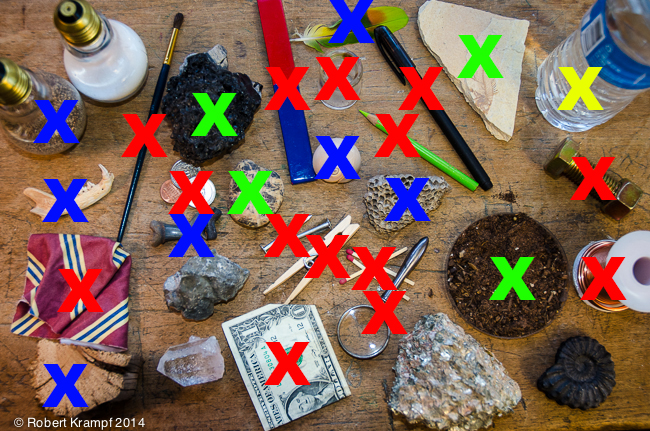
Now that we have gone through each part of the definition, it is time to put them all together. To do this, you will need that same materials you used for the previous parts of the definition:
As many of the items from the following list as you can:
- several mineral specimens
- several rock specimens
- coins, bone, teeth, sea shells, wood, nails, cloth, glass, feather, paper, water, salt, pepper, other objects made of different materials
Place all of the items on a flat surface.

Think back to the first part of the definition, "naturally occurring." Naturally occurring means not man-made, so remove all of the objects that were made by people. That rules out things like paper, cloth, bolts, pens, nails, etc. A red X shows things that are not naturally occurring.

The next part of the definition is "inorganic" which means that it was never part of a living thing. Remove all of the objects that were produced by living things, such as wood, bone, teeth, pepper, shells, feathers, etc. A blue X shows the objects which are not inorganic. Some of the specimens that were removed in the last step were also from living things. I did not remark them as they had already been removed.

"Solid" is the next part of the definition, so remove any object that is a liquid, gas, or plasma. This is where we remove the water.

Minerals have a definite "chemical formula." Remove any specimens that are made up of more than one substance. That excludes things like dirt and rocks that contain more than one kind of mineral.
For "internal crystalline structure" you will have to rely on reference sources. Identify the remaining specimens, and remove any that don't have a crystalline pattern for their molecules. By this point, I have already removed everything that did not fit.

The objects that you have left should all be minerals.
- A quartz crystal.
- A specimen that is made of the mineral muscovite.
- Halite, also known as salt.
- A fossil ammonite that has been completely replace by the mineral pyrite. Because it was totally replaced, none of it was produced by a living thing, so it is inorganic.
- A piece of the mineral calcite.
